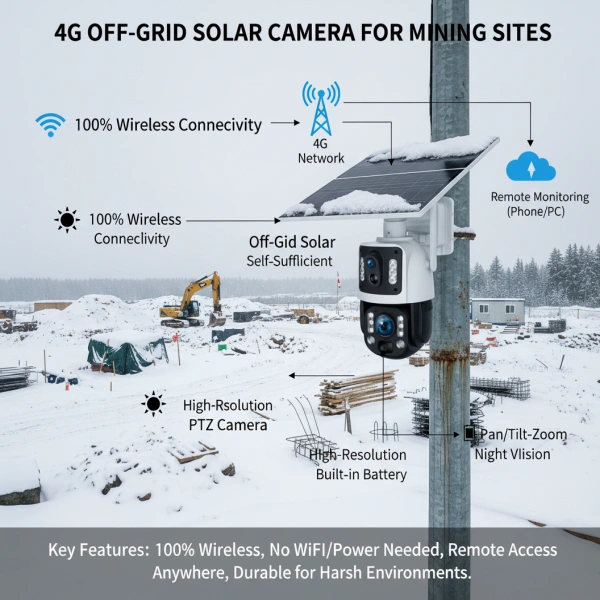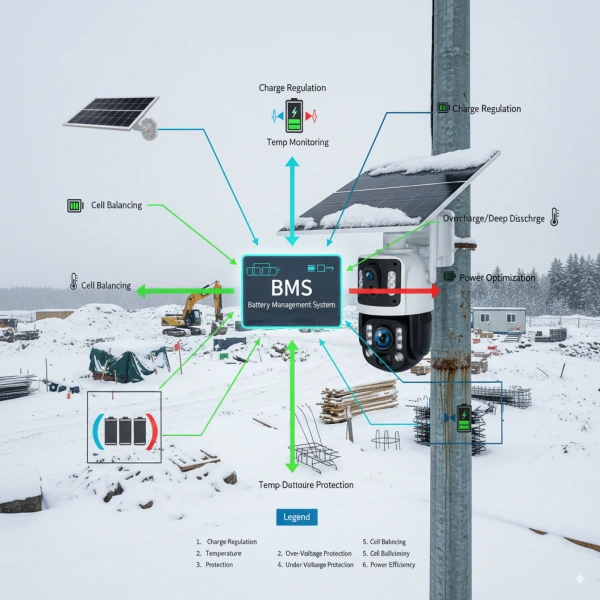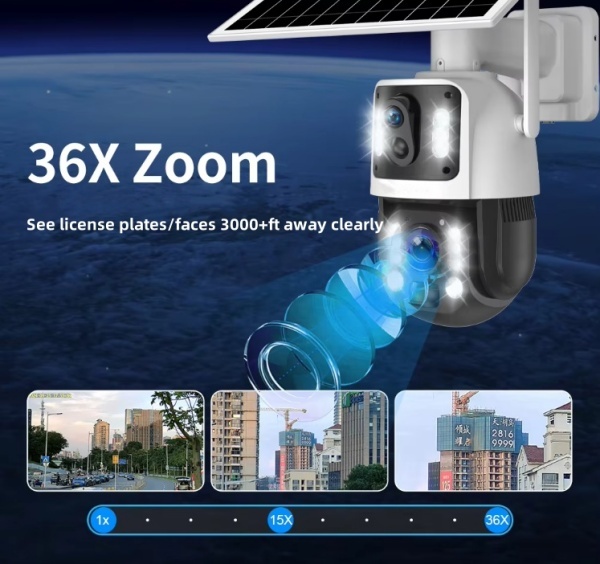Solar 4G Cameras: Off-Grid Security for Farms & Ranches
Farm Security Reinvented: How Solar Security Cameras Prevent Crop Theft and Livestock Loss
For modern farmers and ranchers, security challenges are unlike any other. Vast, open properties, remote locations without power grids, and unreliable Wi-Fi create significant vulnerabilities. These gaps are often exploited, leading to devastating losses from crop theft, livestock rustling, equipment vandalism, and illegal trespassing. Traditional wired security systems are simply not feasible or cost-effective in these environments.
This is where solar-powered security cameras, particularly those with 4G connectivity, have emerged as a game-changing solution. As an engineer with over a decade of experience designing these systems, I’ve seen firsthand how this technology empowers farmers to protect their assets effectively and affordably. It’s not just about recording; it’s about active, real-time prevention, anywhere on your property.
Why Traditional Security Fails on the Farm
The core problem with conventional CCTV systems in an agricultural setting is their dependence on infrastructure. The cost of trenching hundreds, or even thousands, of feet to run power and data cables is prohibitive. It disrupts land and operations, and the ongoing electricity costs add up.
Furthermore, extending a Wi-Fi signal across acres of land is notoriously difficult and unreliable. Signals are easily obstructed by terrain, buildings, and even dense foliage. This leaves critical areas like remote gates, water troughs, and equipment storage sheds completely unprotected, turning them into prime targets for thieves.
The Core Technology: How Solar-Powered 4G Cameras Work
The beauty of a solar-powered 4G security camera lies in its self-sufficiency. Each unit is a standalone security hub, combining four key components: a high-efficiency solar panel, a high-capacity rechargeable battery, the camera itself, and a 4G LTE module.
The solar panel continuously charges the battery during daylight hours, ensuring the camera operates 24/7, even through cloudy days or at night. The integrated 4G module, which uses a standard SIM card, transmits video footage and alerts directly over the cellular network. This completely bypasses the need for local Wi-Fi, allowing you to place a camera virtually anywhere with a cell signal.
At the heart of this system’s reliability is the Battery Management System (BMS). A well-engineered BMS is crucial; it protects the battery from overcharging and over-discharging, manages temperature, and optimizes power consumption. This extends the battery’s lifespan from a single year to three or more, ensuring long-term operational stability in harsh farm conditions. You can learn more about this critical technology in our deep dive on why the BMS is key to solar camera longevity.
To prevent false alarms from wind-blown leaves or non-threatening wildlife, advanced models integrate Passive Infrared (PIR) sensors with AI-powered human and vehicle detection. This ensures you are only alerted to genuine threats, saving battery life and your valuable time.
Key Features for Effective Farm and Ranch Surveillance
When selecting a system, it’s vital to focus on features that directly address agricultural challenges. Not all solar cameras are created equal.
- Long-Range Wireless Connectivity: 4G LTE is the gold standard for large properties. It provides stable, secure access to your cameras from any smartphone or computer, regardless of distance. For areas where a line-of-sight signal is possible but Wi-Fi is weak, specialized 1000 ft wireless security cameras can also bridge significant gaps between buildings.
- Advanced Night Vision: Darkness provides cover for criminals. Look for cameras with Smart Dual-Light technology. This feature uses discreet infrared (IR) for general monitoring but activates a powerful white light when a person is detected, capturing full-color video evidence and acting as a powerful deterrent.
- PTZ (Pan-Tilt-Zoom) Functionality: A single PTZ camera can monitor a vast area. You can remotely pan across a field to check on crops, tilt up to inspect a grain silo, or zoom in on a herd to check for newborn calves. This capability drastically reduces the number of cameras needed.
- Rugged, Weatherproof Design: Farm equipment must be tough. A security camera is no different. An IP66 or higher rating is essential to ensure the camera is fully protected against dust, rain, snow, and extreme temperatures.
Application Case Study: Securing a 500-Acre Soybean Farm
To illustrate the real-world impact, consider one of our clients, a commercial farmer in the Midwest.
- Problem: The farmer was losing an estimated $15,000 annually to the theft of diesel fuel and expensive GPS equipment from tractors parked in a remote field. They also faced issues with illegal dumping along a back access road. With no power or Wi-Fi in these areas, their property was an easy target.
- Solution: We helped them deploy a strategic network of four UBOXCAM 4G Solar PTZ cameras. Two were placed overlooking the equipment storage area, and two were positioned to monitor the primary and secondary entrances to the property. The entire installation was completed by the farmer and his son in under four hours, with no trenching or cabling required.
- Result: The impact was immediate. Within the first six months, all theft and dumping activities ceased. On two separate occasions, the farmer received real-time motion alerts on his phone, allowing him to use the camera’s two-way audio to warn off trespassers and report them to local authorities. The system paid for itself in under eight months, purely from the prevention of asset loss.
Cost-Benefit Analysis: The ROI of Solar Security Cameras
For distributors, installers, and brand owners, understanding the Total Cost of Ownership (TCO) is key to communicating value to the end-user. Solar 4G cameras present a compelling financial argument over traditional systems.
| Cost Factor | Traditional Wired System | Solar 4G Camera System |
|---|---|---|
| Upfront Hardware | Moderate (Cameras, NVR) | Moderate to High (All-in-one unit) |
| Installation & Labor | Very High (Trenching, cabling) | Very Low (DIY-friendly) |
| Ongoing Power Cost | Moderate and Continuous | Zero |
| Ongoing Data Cost | Moderate (Wired Internet) | Low (Affordable SIM data plan) |
| Flexibility & Relocation | Very Low (Fixed installation) | Very High (Move as needed) |
The upfront cost of a solar camera may be slightly higher than a single wired camera, but the TCO is dramatically lower once the exorbitant installation and infrastructure costs of traditional systems are factored in.
Troubleshooting Common Farm Security Camera Issues
Even the best systems can face challenges in the field. Here are solutions to common issues we help our B2B partners and their clients solve:
- Problem: The camera’s battery is draining faster than expected.
Solution: This is often due to excessive false triggers. First, check the camera’s view for moving tree branches or blowing debris and adjust the angle if possible. Next, lower the PIR motion sensitivity in the app settings. Finally, ensure the solar panel is clean and positioned for maximum direct sunlight (typically facing south in the Northern Hemisphere). - Problem: The 4G connection is weak or intermittent.
Solution: Before installation, use a smartphone to check the cellular signal strength from your chosen carrier (e.g., AT&T, Verizon) at the exact camera location. If the signal is weak, opt for a camera model that supports an external high-gain 4G antenna to boost reception. - Problem: Night vision images appear blurry or washed out.
Solution: The most common cause is a dirty lens dome; simply wipe it clean with a soft cloth. Also, ensure the camera is not mounted too close to a light-colored surface (like a white barn wall), which can cause the IR light to reflect back and overwhelm the sensor.
Choosing the Right Solar Camera for Your Farm: A Checklist
For our partners—be you a wholesaler, installer, or Amazon seller—guiding your customers to the right solution is paramount. Use this checklist as a framework for consultation.
- ✅ Assess the Coverage Area: Help the client map out critical zones. Identify key choke points like gates, fuel tanks, barns, and remote pastures that require monitoring.
- ✅ Verify Cellular Signal: Confirm which carriers provide a reliable 4G LTE signal in the specific areas where cameras will be deployed. This is a non-negotiable first step.
- ✅ Calculate Power Requirements: Consider the local climate. A farm in sunny California has different power needs than one in the frequently overcast Pacific Northwest. Recommend a system with an appropriately sized solar panel and battery capacity for the region.
- ✅ Select the Right Features: Does the application require the wide coverage of a PTZ camera or the simple monitoring of a fixed bullet camera? Is color night vision critical for identifying livestock or potential threats?
- ✅ Partner with an Experienced Manufacturer: As a specialized OEM/ODM factory, UBOXCAM provides more than just a product. We offer the engineering expertise to help you customize solutions, ensuring the cameras meet the specific demands of the agricultural market. Contact our team to design a custom security solution for your brand.
By leveraging the power of solar and 4G technology, you can offer farmers and ranchers a security solution that is not only effective and reliable but also perfectly adapted to their unique operational environment. It’s about providing peace of mind, protecting livelihoods, and securing the future of their operations.



